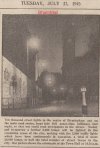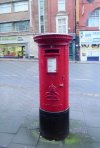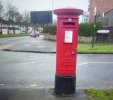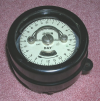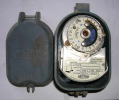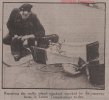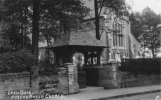Thanks Janice. I don’t think I’ve seen upper case font used on route signs, well at least none spring to mind. Not something I take much notice of, more concerned about getting in the right lane in the right direction. Viv.
-
Welcome to this forum . We are a worldwide group with a common interest in Birmingham and its history. While here, please follow a few simple rules. We ask that you respect other members, thank those who have helped you and please keep your contributions on-topic with the thread.
We do hope you enjoy your visit. BHF Admin Team -
HI folks the server that hosts the site completely died including the Hdd's and backups.
Luckily i create an offsite backup once a week! this has now been restored so we have lost a few days posts.
im still fixing things at the moment so bear with me and im still working on all images 90% are fine the others im working on now
we are now using a backup solution
You are using an out of date browser. It may not display this or other websites correctly.
You should upgrade or use an alternative browser.
You should upgrade or use an alternative browser.
Convention seems to be to use a leading capital followed by lower-case for letters for place names. I say 'seems' because the legislation appears to allow lots of options! [The Traffic Signs Regulations and General Directions 2016 ]Thanks Janice. I don’t think I’ve seen upper case font used on route signs, well at least none spring to mind. Not something I take much notice of, more concerned about getting in the right lane in the right direction. Viv.
i.e.
3.—(1) Any word forming part of a legend provided for in the sign table in this Part may be written—
(a) entirely in lower case letters;
(b) entirely in capital letters; or
(c) in a mixture of capital and lower case letters.
However 'extra' messages, like 'City centre' are written in the legislation in that form. In truth I don't think local authorities or sign writers understand or follow the regulations, (who can blame them?), and I must admit to having successfully challenged 'bad' signs in the past!
Richard Dye
master brummie
The ancient one looks better than the modern! Most likey does not work as well but still looks better!Contrasting lamps: from gas fitted to electric. Viv.View attachment 157164
Bob Davis
Bob Davis
You are lucky to be able to read the road signs, in this neck of the woods they are so dirty, you can barely make them out and a local councillor in Torridge has been threatened with court action for going out and trying to clean them. However that is something I remember as my Dad(and remember he was always right), blew his top when he saw it, wondering if
a) they did not have something better to do
b) had no understanding of English Language
I will not bore you with c to z, but suffice to say we had to trek out in 'lobby' our Morris Minor Series M, reg LOB 148, the one with the headlights in the front wings, and see these. We came home and Dad liked both, he thought all Upper case very clear, but the lower case looked smarter. A couple of bus drivers got a bit annoyed when he slowed down to have a look at them, then he took us to Meriden, I think to look at a sign on a wall there as comparison. Days were much simpler then.
Bob
a) they did not have something better to do
b) had no understanding of English Language
I will not bore you with c to z, but suffice to say we had to trek out in 'lobby' our Morris Minor Series M, reg LOB 148, the one with the headlights in the front wings, and see these. We came home and Dad liked both, he thought all Upper case very clear, but the lower case looked smarter. A couple of bus drivers got a bit annoyed when he slowed down to have a look at them, then he took us to Meriden, I think to look at a sign on a wall there as comparison. Days were much simpler then.
Bob
Eric Gibson
master brummie
There was a tv documentary about the design of road signs for the motorways that went into detail on the subject.
There's a bit about the lady here.
There's a bit about the lady here.
Mark Tooze
master brummie
Street lamps like the one in Mark’s photo above often became the focus of street games, meetings etc. They were certainly a feature of my 1950s childhood. In tag games the lamp post was always “home”. It was the ‘seekers’ counting point in games of hide and seek. And It (dangerously) would often have a rope dangling from the arms for various acrobatic activities. Viv.
Mark, that is a classic view of the museum I remember so well. Super photo.Edit, post copied and edited from the Science Museum thread.
At the old Science Museum Newhall Street
View attachment 161090
Eric Gibson
master brummie
Not quite the same as ours but similar, our cricket stumps. 
Radiorails
master brummie
Noting the lamp standard reminded me that we didn't have street lighting until 1947 were I lived. Notable was the difference in the night sky, on a clear night so much was visible. Light pollution is the order it seems.
mw0njm.
A Brummie Dude
farmerdave
master brummie
Edward Eighth pillar boxes are not all that common due to his very short reign (20th January to 11th December 1936). After doing a Google search it seems as if only two of these pillar boxes have survived in Birmingham. One is in Digbeth (first photo) and the other is in Clay Lane, Yardley (photo 2, apologies for the slight lean).
Attachments
roly
master brummie
Only 1 in 3 electric lamps burned all night. The others switched off at 11pm and re-lit at 5 am. In the summer they didn't re light at all. You could tell which lamps were all night burners as they had a red dot painted on the column, just beneath the ladder arms.Am I right in believing, in the era of timers between lamp-lighters and photocells, the street lights sometimes switched off before it was light in the morning? I'm pretty sure I can remember being left in the dark on my way home from town some mornings. Or is it my ageing memory flickering and dimming, not the lights?
roly
master brummie
They didn't need to be reset for summer / winter! When checking or resetting the clock the time was set by setting the dial against one of 2 pointers. 1 pointer was W and the other S ( winter or summer ) the clock also incorporated a calender as the days passed the calender would advance and move a tiny cam which mechanically moved the switch on / off toggle. The " solar clock " was a masterpiece of miniature engineering.Clockwork timers v Photocells. the old clock work timer had to be reset for British summer time & again in the winter, not always a council priority !
Even now some photocells are set to low and do not come on until total darkness falls,this can be very dangerous for the public on dull rainy days.
We don't actually gain or lose an 'hour of sun' when 'the clocks change' so street lighting clock only needs to cope with solar changes throughout the year, 'clock time' doesn't matter to the street lamp.They didn't need to be reset for summer / winter! ..... The " solar clock " was a masterpiece of miniature engineering.
However the behaviour of people does change with BST/GMT so the need for light might change. At my parents' house we decided that the outside light wasn't needed after 'bedtime' so a 'clockwork' timer that was to hand provides power from about 3pm to midnight, a photocell determining if the lamp needs to be on. Because 'bedtime' follows BST/GMT twice a year I have to change the clock then.
As an aside I coined the term 'digital watch syndrome', (DWS), many, many years ago. DWS is getting to be more commonplace in all aspects of life. It relates to those things that we followed instructions to set up then they run by themselves until one day we need to set them up again and... we haven't got a clue how to do it because we never had to learn how.
mw0njm.
A Brummie Dude
How do the streetlights turn on automatically at night?

The most commonly used component in streetlights is called a cadmium sulphide photoresistor, or a CdS cell for short. The CdS cell changes the resistance of a circuit depending on the amount of light shining on it. When lots of light falls on a CdS cell, then the resistance is very low, which means it conducts electricity well. When there is not much light, the photo-resistor has a high resistance which means not much current can flow.
This change in current can then be used to control a relay. A relay is basically an electromagnetic switch; when the electromagnet has a high current (lots of light falling on the photo-resistor – daytime) then it pushes the switch open so no current can fl ow to the streetlight. When it gets dark, then not much current can flow to the electromagnet so the switch closes and allows electricity to flow to the streetlight, turning it on.
Brummie a long time ago
master brummie
So mounting the photosensor under the light for easy servicing might be a bad design decision ? 
Andrew.
Andrew.
I suspect the photoresistor will have become a photodiode, the relay some sort of solid-state switch and the lamp an array of LEDs!How do the streetlights turn on automatically at night?
The most commonly used component in streetlights is called a cadmium sulphide photoresistor, or a CdS cell for short.
This change in current can then be used to control a relay.
To think that back in 1967/8 I was taken into a back room by my lecturer and allowed to lift the lid of a shoebox and to then peep inside, where an axial-leaded diode was dimly glowing red, my first sight of an operating LED!
Richard Dye
master brummie
I think so! Lights I have mounted for tennis courts and parking lots had the sensors on top or over the illumination source. A sensor below could potentially shadow the demand for power!So mounting the photosensor under the light for easy servicing might be a bad design decision ?
Andrew.
Richard Dye
master brummie
And Pete, most of those clock types worked pretty well. Todays construction has them replaced with photo sensitive switches with no moving mechanical parts that sense light or lack thereof. Some have built in sensors to indicate light or illumination failure and report it.A lot of street lights had a timer clock in the base of the pole-column most of the covers was broken and held on with tape etc later a cable tie was used
View attachment 168622
1960 street light clock
View attachment 168619
1930 street like clock View attachment 168621
The photos of Pillar Boxes reminded me of the I Spy books we used to have as kids and looking for a street items to tick off. Also I Spy on a Train which was good fun on our holiday journey from Snow Hill down to holiday in Devon by steam train.Edward Eighth pillar boxes are not all that common due to his very short reign (20th January to 11th December 1936). After doing a Google search it seems as if only two of these pillar boxes have survived in Birmingham. One is in Digbeth (first photo) and the other is in Clay Lane, Yardley (photo 2, apologies for the slight lean).
devonjim
master brummie
ttps://www.britishtelephones.com/markersjoint.htm?fbclid=IwAR2HMwn5BB0WMORR2CkxXFTUnvzbMV_QNCV1eGAhdHE8wK34n_-T1ZxiQ6k
A bit more info in the same theme. Facebook "Birmingham in Photographs"
GPO - JOINT MARKERS AND MARKING POSTS
GPO - JOINT MARKERS AND MARKING POSTS
www.britishtelephones.com
Well, I remember the Marker, Joint, No. 3’s and the Post, Marker No. 2 as a kid. They were quite a common sight, but not seen one for years now.ttps://www.britishtelephones.com/markersjoint.htm?fbclid=IwAR2HMwn5BB0WMORR2CkxXFTUnvzbMV_QNCV1eGAhdHE8wK34n_-T1ZxiQ6k
A bit more info in the same theme. Facebook "Birmingham in Photographs"GPO - JOINT MARKERS AND MARKING POSTS
GPO - JOINT MARKERS AND MARKING POSTSwww.britishtelephones.com
A Sparks
master brummie
Is it a trig point?What are these ? Seen them in many places. This one is next to the lych gate of St Mary’s Church, Acocks Green. Been there some time as, I think, can be seen in the old photo. Viv.
View attachment 174599
Or more likely a Benchmark?

Know your Benchmarks from your Trig Points
All will become clear, thanks to Richard Mogg, surveyor in our Wimborne office


